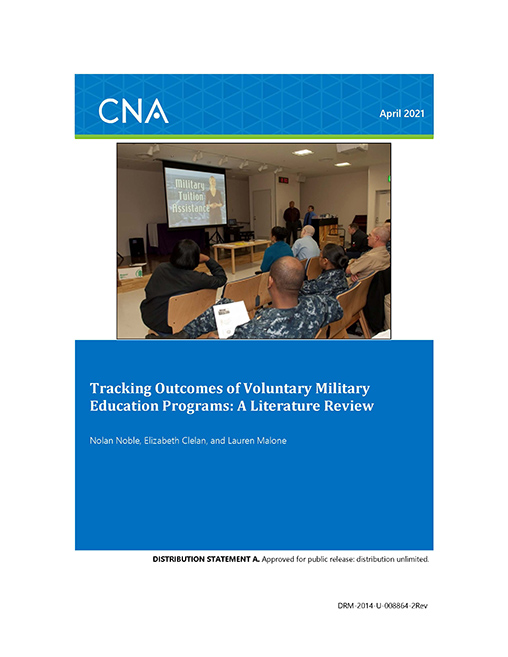The Department of Defense (DoD) provides education benefits to Servicemembers and their spouses to decrease the financial burden of higher education for military Servicemembers and to support the development of portable employment and careers for military spouses. The Tuition Assistance (TA) program provides up to $250 per semester credit hour (or equivalent) with an annual maximum of $4,500 in tuition to active component and some reserve component Servicemembers. TA can be used for certificates, as well as for associate, bachelor’s, and graduate degrees. The My Career Advancement Account (MyCAA) scholarship program is a workforce development program that provides a 3-year maximum of $4,000 of financial assistance to eligible military spouses who are pursuing a license, certification, or associate degree in a portable career field or occupation.
Although there is evidence that, in general, the TA program can be useful in recruiting higher quality personnel, the evidence on TA’s retention benefits is mixed. And, although it is possible that the MyCAA scholarship program for military spouses affects Servicemember recruitment and retention, scant evidence on these effects exists. In addition, there is little current research on the educational and financial outcomes of TA and MyCAA users. This dearth of information prompted Congress to mandate, in the 2014 DoD Appropriations Bill, a study to track the aggregate graduation rates, financial indebtedness, and loan default rates of TA and MyCAA users. The Principal Director of Military Community and Family Policy asked CNA to conduct this congressionally mandated study.
In this preliminary report, we summarize the TA and MyCAA literature—including research on these programs’ use and outcomes. Because few studies have focused on these programs, we also explore the civilian higher education literature to better understand potential educational outcomes for TA and MyCAA users. In doing so, this report provides the relevant background information needed for the quantitative portion of this study, in which we will collect and analyze data on educational outcomes of TA and MyCAA users.
In general, college graduates experience numerous benefits—namely, increased earnings potential, higher employment rates, and an increased quality of life. Therefore, college usually is worth its cost, except possibly for those who:
- Fail to receive their degree (nonattainers)
- Fail to find a job commensurate with their ability (underemployment)
- Take on more debt than their future income warrants (excessive debt)
We expect that the aforementioned reasons why college may fail to be worth its cost for civilian students also will apply to TA and MyCAA users.
There is important and substantive variation across educational sectors in students’ outcomes; students in the private for-profit sector generally have the poorest outcomes (e.g., lowest graduation rates), although these schools also tend to have open enrollment policies that may contribute to students who are less academically prepared at time of enrollment. Private for-profit institutions are more popular among TA users than civilian college students, and TA users spend more at private for-profits than at public or private not-for-profit institutions. Private for-profits represent slightly less than half of TA users (48 percent), but more than half of TA funds (53 percent). The popularity of private for-profits among TA users is a concern because they have substantially higher nonattainment rates and higher proportions of students and alumni with excessive debt. Specifically:
- Nonattainment rates at private for-profits are 85.2 percent. (For comparison, nonattainment rates at public and private not-for-profit institutions are 38.5 percent and 29.3 percent, respectively.)
- Mean debt of bachelor’s degree recipients at private for-profits is $45,042. (For comparison, mean debt of bachelor’s degree recipients at public and private not-for-profit institutions is $12,922 and $18,700, respectively.)
It remains to be seen whether these differential outcomes hold for TA and MyCAA users, who may differ from other students at these institutions in meaningful ways. And private for-profits may offer TA and MyCAA users something that is not offered at many public or private not-for-profit institutions: distance learning options and the ability to pursue courses on a flexible schedule (even while working full-time). The private for-profits have tailored their education services around being able to provide this flexibility for their students, which may make them particularly attractive to TA and MyCAA users.
Download reportDISTRIBUTION STATEMENT A. Approved for public release: distribution unlimited.
Details
- Pages: 62
- Document Number: DRM-2014-U-008864-2Rev
- Publication Date: 4/29/2021
